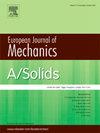Possible cohesive fracture path leading to the rapidest failure of ductile materials under dynamic tension
IF 4.2
2区 工程技术
Q1 MECHANICS
引用次数: 0
Abstract
Fracture velocity for a solid undergoing high-rate plastic flow with an internal fracture depends on a cohesive fracture path at a fracture point and momentum transport process from the surrounding medium to a fracture point. Assuming a more complex nonlinear relationship between fracture cohesion and fracture opening displacement, fracture evolution under different damage models, critical fracture time, Mott wave propagation distance, and analytical or numerical solutions of the average size of fragments are derived in this study. A step-like cohesive fracture path leads to the quickest fracture process, with the step stress on the fracture point being 2/3 of its strength, while maintaining constant fracture strength and energy among all conceivable cohesive fracture paths. For a wide range of loading strain rates, the damage time had a minimum value regardless of the damage evolution path selected for material failure for various damage models. Results obtained in this study based on the principle of rapidest unloading provide a reference to study the intrinsic damage mechanisms in fracture processes.
可能导致韧性材料在动拉作用下快速破坏的内聚断裂路径
具有内部裂缝的高速塑性流动固体的断裂速度取决于断裂点处的内聚断裂路径和从周围介质到断裂点的动量传递过程。假设裂缝黏聚力与裂缝开缝位移之间存在较为复杂的非线性关系,推导出不同损伤模型下的裂缝演化、临界断裂时间、莫特波传播距离以及破片平均尺寸的解析解或数值解。阶梯式黏性断裂路径的断裂速度最快,断裂点上的阶梯式应力为其强度的2/3,在所有可能的黏性断裂路径中,断裂强度和能量保持恒定。在较宽的加载应变率范围内,对于各种损伤模型,无论选择何种损伤演化路径,损伤时间都具有最小值。基于快速卸载原理的研究结果为研究断裂过程中的内在损伤机制提供了参考。
本文章由计算机程序翻译,如有差异,请以英文原文为准。
求助全文
约1分钟内获得全文
求助全文
来源期刊
CiteScore
7.00
自引率
7.30%
发文量
275
审稿时长
48 days
期刊介绍:
The European Journal of Mechanics endash; A/Solids continues to publish articles in English in all areas of Solid Mechanics from the physical and mathematical basis to materials engineering, technological applications and methods of modern computational mechanics, both pure and applied research.

 求助内容:
求助内容: 应助结果提醒方式:
应助结果提醒方式:


